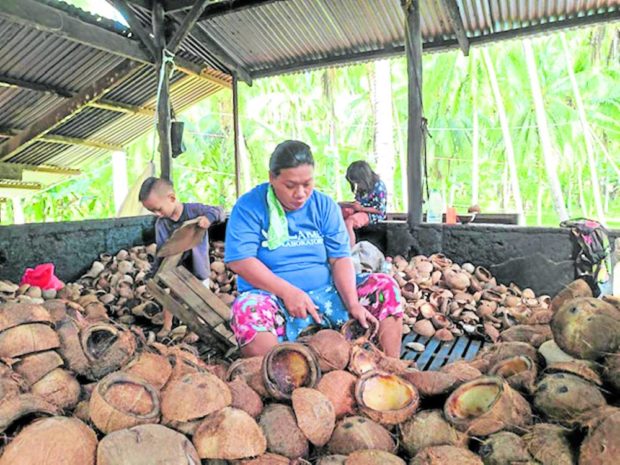
FILE PHOTO: A woman farmer processes the harvested coconuts into copra and other coconut by-products.
The Philippine Coconut Authority (PCA) seeks a higher budget of P2.4 billion next year to improve coconut production nationwide, its top official said on Tuesday.
In an interview, PCA administrator Dexter Buted said the requested budget for 2025—a surge of more than 1,400 percent from this year’s P158 million—will increase the allocation of fertilizers if approved.
READ: Marcos to provide funds for PCA’s plan to plant 100 million coconut trees
“We also need to invest in fertilization because the current budget for this is only 1 percent of the 340 million coconut trees in the country,” he said.
The PCA intends to plant around 8.4 million seedlings this year as part of its massive multi-year plan to revive the local coconut by increasing productivity and improving the livelihood of coconut farmers.
This was higher than more than 2.1 million coconut seedlings planted by the PCA in the previous year.
“So, we have a catch-up plan on how, where and who will plant. So, PCA’s plan is already firm to implement the planting of 100 million coconut trees,” he told reporters.
New coconut trees will mostly be planted in the Visayas and Mindanao since both islands have many processing plants.
“First, climate suitability is still our number one consideration (in choosing the areas for planting coconut seedlings) and we will replace the existing senile coconut trees with new ones),” he added.
Despite the impact of the El Niño phenomenon on the farm sector and the imminent threat of the La Niña phenomenon, Buted said domestic coconut output is projected to steadily increase by 3 to 5 percent, noting the resilience of coconut trees amid changing weather conditions.
READ: Hasten coconut industry modernization, Marcos tells PCA
“If we look at the market’s growth, the production only increases by 3 to 5 percent. That is what we can promise based on the available data on the market. It will increase especially that coconut has many uses,” Buted said.
This multi-year planting initiative, the first of its kind project in the country since the 1970s, will address increasing senility and loss of bearing trees. It is also in line with the Marcos administration’s goal of planting 100 million coconut trees by 2028.
Buted also said the planting project will enable the Philippines to reclaim its spot as the leading coconut producer worldwide. At present, the country is the second largest coconut producer next to Indonesia.
“In the next five to 10 years, we will be able to put the country back on the map as the world’s leading producer of coconut,” he added.
Data from the Philippine Statistics Authority showed the volume of coconut produced totaled 14.89 million metric tons (MT) in 2023, slightly lower than 14.93 million MT a year ago.

